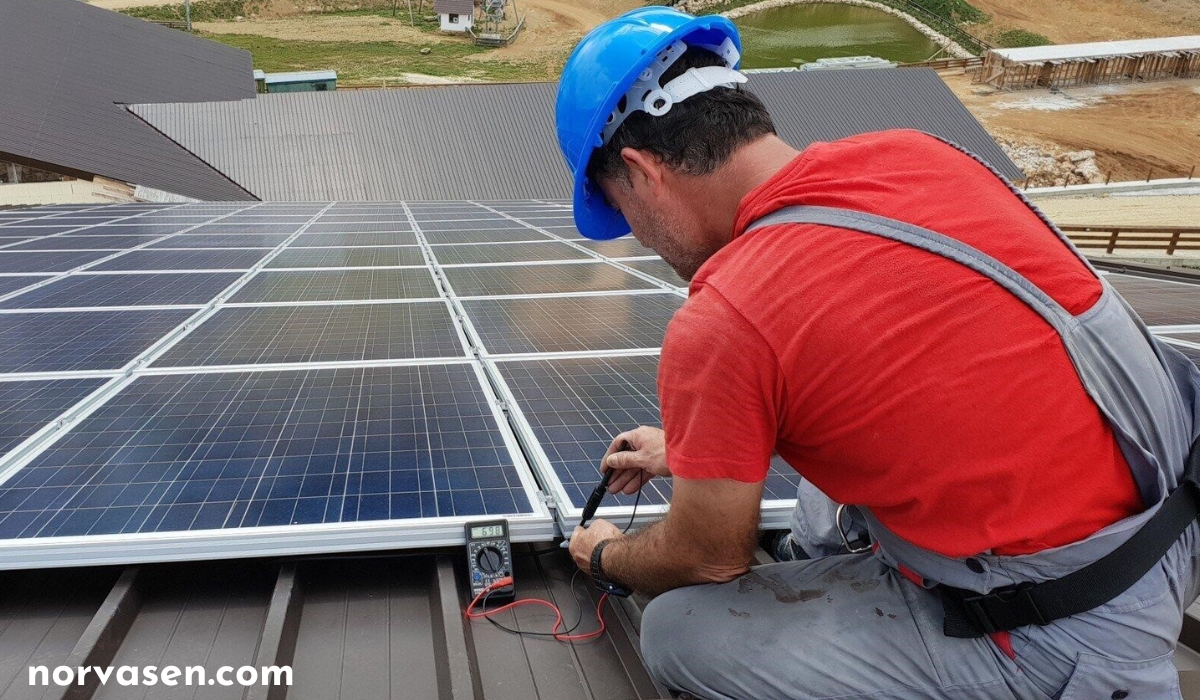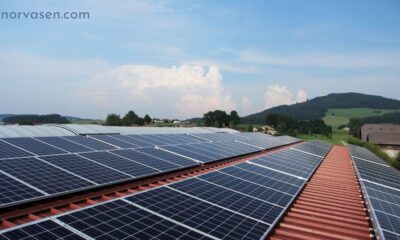Home Improvement
From Installation to Maintenance: What to Expect When Working with a Solar Energy Contractor

Embracing the sun’s energy is a popular choice for both homes and businesses aiming for sustainability. Transitioning to solar power is a big step, and teaming up with a skilled solar energy contractor is key.
Knowing what to expect when working with a solar expert can help make your switch to solar as seamless as the power it produces. Let’s look at the step-by-step process of installing and maintaining solar panels. This will give you the info and confidence you need for this eco-friendly project.
The Initial Consultation: Mapping Out Your Solar Journey
During the first phase of the transition, you’ll have a friendly and detailed chat with your chosen solar energy contractor. This chat is super important because it lays the groundwork for the whole project. You’ll talk about evaluating the benefits of solar, and your energy needs, and check if solar panels can work on your property.
The contractors are good at looking at how much energy you use now. They create a solar system just for you to save money and be efficient.
Your contractor will carefully check your property to make sure they install the solar panels just right. They’ll look at things like your roof’s condition, which way it faces, and if there are any shady spots. These checks are crucial to make sure your solar panels work their best.
They might even use fancy tools to see how much sunlight your property gets all year, helping to guess how much energy you can make. Also, they’ll talk about different solar panels and inverters, giving you advice on which ones are perfect for your home or business.
Taking Care of Paperwork: Permits and Regulations
When you decide to install solar panels, there will be some paperwork to handle, like permits and applications for incentives. Your solar contractor should know all the rules and codes in your area. They will take care of getting the permits and making sure the solar panel installation meets all the rules.
A good solar energy provider doesn’t just deal with paperwork. They can also explain the money-saving benefits, like tax credits and rebates.
They can help you with the forms and deadlines, so you can get all the savings available. They can also give you advice on financing options, like solar loans or leases, to help you manage the costs.
The Installation Process: Bringing Your Solar System to Life
With the planning all set and permits ready to go, your contractor will soon be arranging the installation for you. This exciting process usually takes a few days and involves some important steps.
First, they will carefully position the solar panels to soak up as much sunlight as possible. Then, they’ll set up the wiring and inverters needed to turn that sunlight into electricity for your home. Finally, they’ll connect the system to your electrical grid, seamlessly blending it with your current power setup.
During the installation, safety and precision are key. Experienced contractors pay close attention to detail. They make sure each panel is securely mounted and every connection meets top-notch standards.
They understand the importance of lasting quality in their work since it will face years of weathering. The crew is well-trained in safety measures, wearing the right gear and using specialized tools to keep everyone safe.
After installation, the team will thoroughly test the system to ensure it works well and is efficient. They’ll check each part to confirm everything is in top shape.
They’ll also do their best to cut any disruption to your daily life. They can work with you to schedule convenient times and keep the work area tidy throughout the project.
Once the installation is complete, the contractor will provide you with a detailed overview of your new solar system, explaining how it works and offering tips on solar maintenance to ensure it continues to perform optimally. They may also provide documentation for warranties and customer support, ensuring you have all the resources you need to enjoy the benefits of solar energy for years to come.
Post-Installation Procedures: Quality Checks and Grid Integration
After the solar panels are set up, your contractor will carefully check everything. They’ll make sure the system meets the design and safety standards before connecting it to the power grid. Using special tools, they’ll measure the system’s performance to ensure it works as expected.
Next, your contractor will work with the local utility company to connect your system. This step may involve more inspections and approvals.
Once everything is good to go, your solar panels will start producing power for your home or business. Your contractor will also give you clear instructions on how to keep an eye on your system and what to do if any problems arise.
The Maintenance Regimen: Ensuring Long-Term Solar Panel Efficiency
To keep your solar energy system working its best, it’s important to take care of it. Your solar energy provider can help by checking and cleaning it regularly. They’ll look for any damage, keep an eye on how much energy it’s making, and clean off any dirt that might be on the panels.
Taking care of your solar system isn’t just about making it work well; it also helps protect your warranty and keeps it running for a long time. Your contractor will give you a schedule and tips to help you take care of your system. They might even offer software to track how much energy you’re making.
By staying ahead of any problems, you can enjoy a smoothly running system for years to come.
Embracing Solar Energy and Work with the Best Solar Energy Contractor Today
Switching to solar energy is a smart, eco-friendly choice. With the help of a skilled solar energy contractor, the process becomes seamless. From the initial consultation to ongoing maintenance, each step is clear and manageable.
By knowing what to expect, you can happily welcome solar technology, enjoying savings in the long run and helping the environment. Your contractors will make sure your solar system runs smoothly and continues to provide clean energy reliably.
For more captivating reads and diverse subjects, don’t forget to check out the other articles on our blog. Happy reading!
Home Improvement
How to Budget for Major Home Improvement Projects

Home improvement projects can be both exciting and overwhelming. Whether you’re renovating a kitchen, adding a new room, or undertaking a major exterior overhaul, the scope of these projects can be vast and complex. One of the most critical aspects of managing a successful home improvement project is budgeting. A well-planned budget not only helps you manage your finances effectively but also ensures that you complete the project without unexpected financial strain. In this guide, we’ll explore the steps and strategies necessary to budget effectively for major home improvement projects, so you can achieve your renovation goals without compromising your financial stability.
Define Your Project Scope and Goals
Before you can start budgeting, it’s essential to define the scope and goals of your project. Begin by clearly outlining what you want to achieve. Are you looking to modernize your kitchen with new appliances and countertops? Or perhaps you want to expand your living space with a new addition? The more specific you are about your project’s goals, the better you can estimate the costs involved.
Consider creating a detailed plan or blueprint of the project. This plan should include all the major components, such as materials, labor, and any additional features you want to incorporate. By having a clear understanding of what you want, you can create a more accurate budget and avoid unnecessary expenses.
Budgeting for Roof Improvements
When budgeting for roof improvements, it’s crucial to plan for both expected and unexpected costs. Start by getting estimates from several contractors to compare pricing and services. A local roofer can provide insights into regional material costs and potential issues specific to your area. Include expenses for materials, labor, and any necessary permits in your budget. Additionally, set aside a contingency fund to cover unforeseen problems, such as hidden damage or structural issues. By carefully planning and researching, you can manage your roofing project’s budget effectively and ensure that your home remains protected and aesthetically pleasing.
Research and Gather Cost Estimates
With a clear project scope in hand, the next step is to gather cost estimates. Research the materials, labor, and any other expenses associated with your project. Start by obtaining quotes from contractors, suppliers, and service providers. Online resources and home improvement forums can also provide valuable insights into current pricing trends and cost expectations.
When gathering estimates, make sure to get multiple quotes for each component of your project. This will help you compare prices and identify the best deals. Keep in mind that the lowest quote may not always be the best option. Consider the reputation and reliability of the service providers, as well as the quality of materials they use.
Create a Detailed Budget Breakdown
Once you have gathered cost estimates, it’s time to create a detailed budget breakdown. This involves categorizing all the expenses associated with your project and allocating funds accordingly. Your budget should include:
- Materials: This includes all the building materials, fixtures, and finishes required for the project.
- Labor: Estimate the cost of hiring contractors, electricians, plumbers, and any other professionals needed.
- Permits and Fees: Many home improvement projects require permits, which can come with associated fees.
- Contingency Fund: It’s wise to set aside a contingency fund for unexpected expenses that may arise during the project.
A detailed budget breakdown helps you visualize where your money is going and ensures that you allocate funds appropriately for each aspect of the project.
Factor in Additional Costs and Contingencies
In addition to the primary costs of materials and labor, there are often additional expenses that can arise during a home improvement project. These can include:
- Design and Planning Fees: If you hire an architect or designer, their fees should be factored into your budget.
- Temporary Accommodations: If your project involves significant disruption, you might need to budget for temporary housing.
- Cleanup and Disposal: Costs associated with debris removal and cleanup should also be considered.
To safeguard against unforeseen issues, allocate a contingency fund, typically around 10-20% of the total project cost. This buffer can help cover unexpected expenses and prevent budget overruns.
Set a Realistic Timeline and Payment Schedule
A realistic timeline and payment schedule are crucial components of a successful home improvement budget. Start by estimating the duration of each phase of the project, from planning and design to construction and finishing.
Establish a payment schedule that aligns with the project timeline and milestones. Many contractors require deposits or progress payments, so ensure that your budget accounts for these requirements. Clear communication with your contractor about payment terms and schedules can help avoid misunderstandings and financial strain.
Track and Monitor Your Expenses
Once your project is underway, it’s essential to track and monitor your expenses to stay within budget. Keep detailed records of all invoices, receipts, and payments. Regularly compare your actual expenses with your budgeted amounts to identify any discrepancies.
Consider using budgeting tools or apps to help manage and track your spending. These tools can provide real-time updates and help you stay on top of your financial goals. If you notice any potential budget overruns, address them promptly to prevent further financial strain.
Budgeting for major home improvement projects is a critical step in ensuring that your renovation goals are achieved without financial strain. By defining your project scope, gathering cost estimates, creating a detailed budget breakdown, and monitoring your expenses, you can manage your finances effectively and enjoy a successful renovation.
Remember that flexibility and adaptability are essential components of budgeting. Unexpected challenges may arise, but with careful planning and open communication, you can navigate these obstacles and achieve your home improvement goals.
With a well-structured budget and a clear understanding of your project’s financial requirements, you can transform your home into the space you’ve always envisioned, all while staying within your budgetary constraints.
Home Improvement
6 Best Tips for Maintaining Your Fireplaces Working in 2024

Imagine sitting by a warm, crackling fire on a cold night. A well-kept fireplace is the best way to relax. However, to keep that inviting glow going strong, regular upkeep is essential.
In 2024, taking care of your fireplace means more than just cleaning it once in a while. This blog will share six expert tips to ensure fireplaces Melbourne remains efficient, safe, and ready to provide warmth when you need it most.
1. Regular Cleaning and Inspection
To keep your fireplace working well in 2024, it’s crucial to clean and inspect it regularly. This involves removing ash and soot from the firebox and ensuring there are no obstructions.
Regular cleaning helps prevent build-up that could affect performance or pose a fire hazard. An inspection should include checking for any visible damage or wear. Ideally, you should clean your fireplace after each use and schedule a professional inspection once a year.
2. Ensure Proper Ventilation
Proper ventilation is essential for the safe and efficient operation of your fireplace. Make sure the vents and flues are clear of obstructions to allow smoke and gases to exit your home properly.
Poor ventilation can lead to dangerous smoke backdrafts or increased creosote build-up, which can be a fire hazard.
3. Use Quality Fuel
Using quality fuel is important for a clean and efficient burn. Whether you’re using wood, pellets, or gas, make sure the fuel is dry, clean, and appropriate for your fireplace.
Wet or dirty wood can create excess smoke and creosote, which can clog the chimney and reduce efficiency. For gas fireplaces, ensure you’re using the correct type of gas and that it’s properly connected.
Quality fuel not only improves performance but also extends the life of your fireplace and reduces maintenance needs.
4. Inspect and Maintain the Chimney
Regular inspection and maintenance of the chimney are vital for fireplace safety. The chimney should be checked for blockages, cracks, or damage that could impair its function.
Creosote build-up inside the chimney can increase the risk of a chimney fire, so it’s important to have it cleaned regularly. Schedule a professional chimney sweep at least once a year to ensure that the chimney is in good condition and free of hazards.
5. Addressing Cracks and Damage
Cracks in the firebox or surrounding masonry can allow heat to escape, leading to potential damage to your home or increased risk of fire. Inspect your fireplace regularly for any signs of damage and repair them as soon as possible.
For significant damage, it’s best to consult a professional who can assess and fix the issues. Timely repairs help maintain the integrity of your fireplace and ensure it remains safe and functional.
6. Install and Use Fireplace Screens
Fireplace screens prevent sparks and embers from escaping the firebox, which can reduce the risk of accidental fires or burns. They also keep pets and children safe from getting too close to the flames. Make sure the screen is properly fitted and made from a heat-resistant material. Regularly check the screen for any damage or wear and replace it if needed.
Ensure Safe and Efficient Fireplace Operation
Maintaining your fireplace with care and attention is crucial for ensuring its safe and efficient operation throughout the year. By following these tips, you can enjoy the warmth and comfort of your fireplace while minimizing risks.
Home Improvement
5 Best Tips When Finding a Professional Pest Manager

Getting rid of pests can be hard and stressful, and you need to act quickly and effectively to stop the problems from getting worse.
In 2024, it is important to find a skilled and reliable pest manager to keep your home free of pests and safe for you and your family. This blog will share five essential tips to help you find a Professional Pest Manager you can trust.
1. Read the Reviews
Before you hire a pest manager, look at what other people have said about them. Reviews can tell you a lot about how reliable they are, how good their service is, and how happy their customers are.
Check with past clients to see how well they dealt with pest issues, how professional they were, and if there were any problems. You can find useful information on sites like Yelp, Google Reviews, or even the testimonials section of their own website.
2. Set a Budget
Set a budget for pest control services that takes into account the type of pests you have and how bad the problem is. Prices can vary depending on the size of your property and the severity of the pest problem.
To compare prices and services, get quotes from more than one pest control company. When prices seem too low, you should be careful because there may be hidden costs or less thorough service.
3. Stay Local
There are benefits to hiring a local pest manager. Usually, they know more about the pests that live in the area and the things in the environment that can make pest problems worse.
Also, local managers can act quickly in emergencies and offer ongoing help if needed. You can look in local business directories, ask your neighbors for suggestions, or read ads in your area.
4. Communicate the Scope of Your Needs
Tell the pest manager exactly what you want and what problems you are having with pests. If you have seen pests, please describe where they are, what kind of pests, and any worries you have about the chemicals or methods used to get rid of them.
A good pest manager will listen to your concerns and explain their approach to solving the problem. They should also provide information on safety precautions for pets and family members.
5. Make Sure They Are Licensed
Ensure that the pest manager is licensed and certified to perform pest control services in your area. Licensing requirements vary by state or country and help ensure that the manager is trained in safe and effective pest control practices. Ask for proof of their license and inquire about their experience dealing with your specific pest issues.
Find the Best Professional Pest Manager
Finding the best professional pest manager ensures effective pest control tailored to your needs. By prioritizing these ideas, you safeguard your home from pests while ensuring safety and peace of mind. So, choose wisely to maintain a pest-free environment and protect your property.
-

 Tech5 months ago
Tech5 months agoExploring the Features of Innocams: The Future of Security
-

 Home Improvement3 months ago
Home Improvement3 months agoEco-Friendly Round Rug Options for Sustainable Living in NZ
-

 How-To Guides2 months ago
How-To Guides2 months agoComprehensive Guide to Cockwarming: Enhancing Intimacy and Connection
-

 Fashion3 months ago
Fashion3 months agoBlack Magic: The Elegance and Sophistication of Ultimate Homecoming Dresses in Black
-

 Apps and Games3 months ago
Apps and Games3 months agoDiscover Tickzoo: The Ultimate Platform for Video Content Lovers and Creators
-

 Business5 months ago
Business5 months agoUnlock Potential: Explore Pikruos Services
-

 Blog3 weeks ago
Blog3 weeks agoPossiblyethereal: Exploring the Ethereal Unveiling Abstract Ideas
-

 Entertainment4 months ago
Entertainment4 months agoDiving into the Audio-Visual Experience with AV Tub: Innovating Our World of Media


















